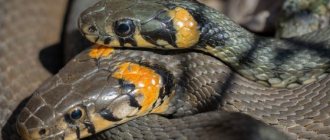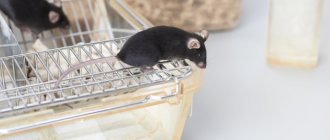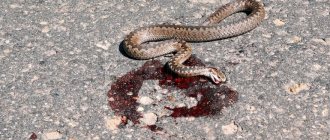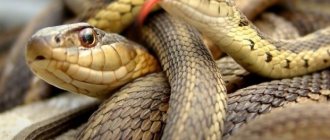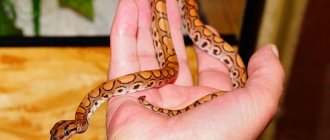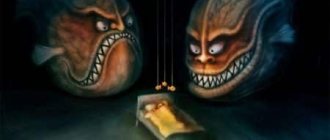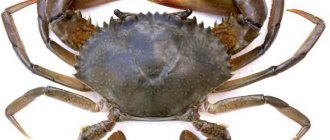Snakes fascinate with their beauty, mystery and incredible calm. The calmness of snakes is paired with their fury during an attack - this trait gives snakes their charm. Motley-colored snakes attract special attention because, in addition to beauty, they carry the destructive power of their poison.
To get to know these snakes better, look at photos of red snakes on the Internet.
King Cobra
The king cobra is not only beautiful, but also extremely dangerous. Its venom is the most deadly compared to the venom of all representatives of this species, and its length is about 3–4 meters.
Its color ranges from dark brown to yellow-green, and the hallmark of such a snake is its exquisite hood.
Photo source: https://pets2.me/
California garter snake
The California garter snake is a member of the subspecies of garter snakes. It is not at all dangerous and is very popular among experienced collectors and beginners.
The color of this type of snake is very diverse and each Californian snake is beautiful in its own way, and of course, it’s up to you to choose which one is more beautiful.
6
Rainbow boa
This beautiful representative of the reptile family lives in Central and South America. Its scales are usually bright red, but in the sun they shimmer with all the colors of the rainbow.
Rainbow boas reach a length of about two meters, swim well and feed on small mammals like voles.
Photo source: https://zooclub.org.ua/
Anaconda / Eunectes murinus
Among the dangerous giant scaly inhabitants of the planet, one of the most beautiful is the anaconda. Europeans first saw this huge creature in 1553.
The main color of the anaconda is grayish-green with two rows of dark spots. There are rows of small yellow spots on the sides. The body is massive, which is why it has practically no enemies in wildlife. Few people would dare to fight such a giant.
It feeds on mammals, and when settling near a person’s home, it attacks domestic animals. There are many legends associated with it, on the basis of which works of fiction have been written and films have been made.
9
Belcher
Belchera is a sea snake. It lives in salt waters of Indonesia. In general, Belchers are friendly, but if angered, they are very aggressive and poisonous.
Belchera has a striped color, which allows it to hide unnoticed among the algae. And in crystal clear water it looks simply incredible.
Photo source: https://travelask.ru/
Sandy ephas / Echis carinatus
You can meet a small snake in the countries of Central Asia, Southeast Asia and the USA. It grows no more than 75 cm. In spring and autumn it is nocturnal, and in summer it is active during the day.
They have a light zigzag stripe on their sides, and the body itself is covered in dark, almost diamond-shaped spots. It moves along the sands using a kind of lateral movement. First he throws his head to the side, and then pulls his body up.
In India they are called rana, and in the USA - saw-scaled viper. It feeds on rodents and can hunt scolopendras and lizards. But, no matter what it is called, it is a very poisonous reptile.
By the way, on our website topcafe.su there is an interesting article about the most poisonous frogs in the world.
5
Horned viper
Despite the horns and aggressive appearance, this snake is very friendly. She will not attack a person first and will bite solely for the purpose of self-defense. Its scales rise up to look like sharp spines. The viper lives in the deserts of North Africa, and during the day it sleeps, burying itself in the sand. Therefore, when walking along the African sands, look carefully at your feet.
Photo source: https://www.zoopicture.ru/
Lifestyle and enemies
The coral adder is quite difficult to find and then to catch. Adders spend a significant part of their time buried in the ground or in fallen leaves. Snakes rise to the surface only in rain and during the breeding season. Some species, including Micrurus surinamensis, typically live in bodies of water with fairly dense vegetation.
This is interesting! The indigenous people of Brazil have a long-standing belief that coral adders carry a small snake around their necks, which inflicts a strong bite.
Any species belonging to the asp family uses a pair of small teeth located on the upper jaw to bite. A characteristic feature of the coral adder is the ability to hold teeth in the wound for a long time, which allows the poison to exert its effect as quickly as possible. Very often, adders bite a person completely by accident, while working in the garden.
The wound from a bite is most often almost invisible, which is due to the small teeth of the snake . The first signs of a bite are severe pain. The most common symptoms of a bite and intoxication include severe, sometimes repeated vomiting, which may be with blood, as well as severe bleeding from the wound.
Severe headaches often occur. In extremely rare cases, signs characteristic of acute cardiovascular failure are observed, followed by the development of paralysis and death.
White Texas Snake
This snake is called a rat snake because it resembles the color of a white rat. Its snowy color has an admixture of soft pink, similar to the circulatory system of this animal. And her head is flattened and resembles a mouse muzzle. However, the snake is not so harmless in appearance. The snake is non-venomous, but its bites are painful and can cause allergies. But despite this, breeders love him very much.
Photo source: https://fotovmire.ru/
Recommendations
Quotes
- ^ a b
"
Pseudechis porphyriacus
".
IUCN Red List of Threatened Species
.
2017
: e.T42493274A42493282. 2022 Doi:10.2305/IUCN.UK.2018-1.RLTS.T42493274A42493282.en.| date = / | doi = mismatch - ^ a b c
Australian Biological Resources Survey (26 August 2013).
"A species of Pseudechis porphyriacus
(Shaw, 1794)."
Handbook of Australian Fauna
. Canberra, Australian Capital Territory: Department of Environment, Water, Heritage and the Arts, Australian Government. Retrieved December 6, 2022. - Species Pseudechis porphyriacus
at the Reptile Database. www.reptile-database.org. - ^ a b c
Shaw, George (1794).
Zoology of New Holland
. London, UK: J. Sowerby. pp. 27–28. - ^ a b
Williams, David;
Wüster, Wolfgang; Fry, Brian Grieg (2006). "The good, the bad and the ugly: Australian snake taxonomists and the history of taxonomy of Australia's venomous snakes." Toxicon
.
48
(7): 919–30. doi:10.1016/j.toxicon.2006.07.016. PMID 16999982. - Liddell and Scott 1980, para. 579.
- Lacepede, B. G. E. (1804). "Mémoire sur plusieurs animaux de la Nouvelle-Hollande dont la description n'a pas encore été publiée." Annales du Muséum National d'Histoire Naturelle.
Paris .
4
: 184–211 [209], [pl. 56 pics 1]. - Lesson, R. P. (1826). "Reptiles".. In Duperrey, LI (ed.). Voyage Autour du Monde, Exécuté par Ordre du Roi, sur la Corvette de sa Majesté, La Coquille, Pendant les Années 1822, 1824 and 1825. Zoologie, Atlas
. Paris: Arthus Bertrand. - Schlegel, Hermann (1837). Essai sur la Physionomie des Serpens.
Partie Générale et Partie Descriptive (In French).
2
. La Haye: Kips and Stockum. pp. 479–80. - Table X from: Zoology and botany of New Holland and adjacent islands
/ zoological part George Shaw, botanical part James Edward Smith; figures James Sowerby. - Wagler, Johann Georg (1830). Natürliches System der Amphibien, mit vorangehender Classification der Säugethiere und Vogel
(in German). Munich, Germany: Cotta'schen. paragraph 171. - McKay, Roy D. (1953–54). "Revision of the Pseudecis
."
Proceedings of the Royal Zoological Society of New South Wales
.
74th
: 15–23. - Liddell and Scott 1980, para. 795.
- Liddell and Scott 1980, para. 295.
- Worrell, Eric (1961). "Herpetological Name Changes" (PDF). Western Australian Naturalist
.
8
: 18–27. Archived from the original (PDF) on 2012-03-19. Retrieved 2012-01-17. - Maddock, Simon T.; Childerston, Aaron; Fry, Brian Grieg; Williams, David J.; Barlow, Axel; Wüster, Wolfgang (2017). "Multilocus phylogeny and species identification of Australo-Papuan black snakes ( Pseudecis
Wagler, 1830: Elapidae: Serpentes)" (PDF).
Molecular phylogenetics and evolution
.
107
: 48–55. Doi:10.1016/j.ympev.2016.09.005. HDL:2436/621498. PMID 27637992. - ^ a b
Hoser, Raymond (2003).
"A reassessment of the taxonomy of Red-bellied black snakes (genus Pseudecis
) with descriptions of two new subspecies" (PDF).
Boydii - Journal of the Herpetological Society of Queensland
(Autumn (May)): 15–18. - Kaiser, Hinrich; Crother, Brian I.; Kelly, C. M. R.; Luiselli, Luca; O'Shea, Mark; Ota, Hidetoshi; Passos, Paulo; Schleip, Wulf D.; Wüster, Wolfgang (2013). "Best Practices: In the 21st Century, taxonomic decisions in herpetology are only acceptable if they are supported by a body of evidence and published through peer review" (PDF). Herpetological Review
.
44
(1): 8–23. - ^ a b c d f g gram h i j k l m p o p
Beatson, Cecily (5 May 2022).
"Red-bellied Black Snake." Australian Museum website
. Australian Museum. Retrieved May 19, 2022. - Troy, Jakelin (1993). Sydney Language
(PDF). Canberra: self-published. paragraph 53. ISBN 0-646-11015-2. - ^ a b
Sutherland and Tibballs 2001, para. 139. - ^ a b c
Australian Reptile Park. "Red-bellied Black Snake." Somersby, New South Wales. Archived from the original on January 3, 2008. Retrieved December 28, 2007. - Australian Broadcasting Corporation (3 October 2014). "Huge red bellied black snake surprises Newcastle Wrangler called in to remove it." ABC News
. Retrieved December 4, 2022. - Greer 1997, para. 163.
- Bennett, George (1860). A Naturalist's Encounters in Australasia: Observations Chiefly of the Animals and Plants of New South Wales, New Zealand, and Some of the Islands of Australia
. London: J. Van Vorst. pp. 274–76. - Krefft, Gerard (1869). Snakes of Australia: An Illustrated and Descriptive Catalog of All Known Species
. Sydney, NSW: T. Richards, Government Printing Office. pp. 46–47. - Hutchinson, Mark; Williams, Ian (2018). "The Key to the Snakes of South Australia" (PDF). South Australian Museum
. Government of South Australia. Retrieved February 8, 2022. - Macdonald, Stuart. "Searching for the Snake Scale Counter." Online Database of Australian Reptiles
. Retrieved May 3, 2022. - ^ a b
Sutherland and Tibballs 2001, para. 140. - ^ a b c d f f
Shine, Richard (1987).
"Intraspecific differences in thermoregulation, locomotion and habitat use of Australian black snakes, Pseudechis porphyriacus
(Elapidae)" (PDF).
Journal of Herpetology
.
21
(3): 165–77. Doi:10.2307/1564479. JSTOR 1564479. - Mircin, Rasmussen and Weinstein 2022, para. 116.
- ^ a b
Gilbert, P. (1935).
"Black snake" Proceedings of the Royal Zoological Society of New South Wales
.
55
: 35–37. - ^ a b
Greer 1997, p. 139. - ^ a b c
Mirchin, Rasmussen and Weinstein 2022, para. 117. - Greer 1997, para. 140.
- Mirchin, Rasmussen and Weinstein 2022, para. 43.
- Ormsby, A. (1952). "Notes on Snake Hibernation in New South Wales." Proceedings of the Royal Zoological Society of New South Wales
.
71
: 25–27. - Hoser, Raymond T. (1980). "Further records of assemblages of various species of Australian snakes". Herpetofauna
.
12
(1): 16–22. - Shine On, Richard; Grigg, Gordon C.; Shine, Terry J.; Harlow, Peter (1981). "Mating and male combat in Australian black snakes, Pseudechis porphyriacus
" (PDF).
Journal of Herpetology
.
15
(1): 101–07. Doi:10.2307/1563652. JSTOR 1563652. - ^ a b c d
Sutherland and Tibballs 2001, para. 141. - Cogger, Harold G. (1983) [1979]. Reptiles and Amphibians of Australia
(Ed. Ed.). Reid. item 449. ISBN 978-0-88359-048-5. - Shine On, Richard (1978). "Growth rates and sexual maturation of six species of Australian cartilaginous snakes". Herpetologica
.
34
(1):73–79. JSTOR 3891614. - ^ a b
Eipper, Scott (2012).
A Guide to Australian Snakes in Captivity: Elapids & Colubrids
. Reptile Publications. p. 237. ISBN 978-0-9872447-8-9. - Greer 1997, para. 145.
- ^ a b
Greer 1997, p. 147. - Phillips, Ben L.; Shine On, Richard (2006). "Invasive species causes rapid adaptive changes in native predator: cane toads and black snakes in Australia." Proceedings of the Royal Society B: Biological Sciences
.
273
(1593): 1545–50. Doi:10.1098/rspb.2006.3479. PMC 1560325. PMID 16777750. - Broad, A. J.; Sutherland, SK.; Coulter, A. R. (1979). "The lethality of mice from dangerous Australian and other snake venoms". Toxicon
.
17
(6): 661–64. Doi:10.1016/0041-0101(79)90245-9. PMID 524395. - Johnston, Christopher I.; Ryan, Nicole M; Page, Colin B; Buckley, Nicholas A; Brown, Simon G.A.; O'Leary, Margaret A; Isbister, Geoffrey K. (2017). "Australian Snakebite Project 2005–2015 (ASP-20)" (PDF). Medical Journal of Australia
.
207
(3):119–25. doi:10.5694/mja17.00094. PMID 28764620. S2CID 19567016. - ^ a b c
Mircin, Rasmussen and Weinstein 2022, para. 119. - Mircin, Rasmussen and Weinstein 2022, para. 101.
- ^ a b
Mirchin, Rasmussen and Weinstein 2022, para. 110. - Weinstein, Scott; Mircin, Peter J.; Tristram, Hamish; Lawton, Luke; White, Julian (2018). "Local incidence of red-bellied snake ( Pseudechis porphyriacus
, Elapidae) envenomation: two cases and a summary of treatment."
Toxicon
.
142
: 34–41. doi:10.1016/j.toxicon.2017.12.047. PMID 29269114. - ^ a b
Churchman, Andrew;
O'Leary, Margaret A. Buckley, Nicholas A; Page, Colin B; Tankel, Alan; Gavaghan, Chris; Holdgate, Anna; Brown, Simon G. A.; Isbister, Geoffrey K. (2010). "Clinical effects of Red-bellied black snake ( Pseudechis porphyriacus
) envenomation and correlation with venom concentration: Australian Snakebite Project (ASP-11)."
Medical Journal of Australia
.
193
(11):696–700. Doi:10.5694/j.1326-5377.2010.tb04108.x. PMID 21143062. S2CID 15915175. - Vaughan, Gary T.; Scully, Thomas B.; Tyrrell, Roy (1981). "Isolation of a hemolytic toxic phospholipase from the venom of the Australian red-bellied black snake ( Pseudechis porphyriacus
)."
Toxicon
.
19
(1):95–101. Doi:10.1016/0041-0101(81)90121-5. PMID 7222091. - Schmidt, J. J.; Middlebrook, J. L. (1989). "Purification, sequencing and characterization of pseudodexine phospholipases A2 from Pseudechis porphyriacus
(Australian red-bellied black snake)".
Toxicon
.
27
(7): 805–18. Doi:10.1016/0041-0101(89)90048-2. PMID 2675391. - Sutherland and Tibballs 2001, para. 142.
- Heller, J.; Bosward, K.L.; Hodgson, J.L.; Cole, FL.; Reid, S.W.; Hodgson, D.R.; Mellor, D.J. (2005). "Snake venom in dogs in New South Wales." Australian Veterinary Journal
.
83
(5):286–92. Doi:10.1111/j.1751-0813.2005.tb12743.x. PMID 15957391. - Heller, J.; Bosward, K. L.; Hodgson, D. R.; Potti, R. (2006). "Anuric renal failure in a dog following red-bellied black snake ( Pseudechis porphyriacus
) envenomation."
Australian Veterinary Journal
.
84
(5): 158–62. Doi:10.1111/j.1751-0813.2006.tb12769.x. PMID 16739524.
Books Cited
- Greer, Allen E. (1997). Biology and evolution of Australian snakes
. Chipping Norton, NSW: Surrey Beatty and Sons. ISBN 978-0-949324-68-9 .CS1 maint: ref=harv (communication) - Liddell, Henry George; Scott, Robert (1980) [1871]. Greek-English Lexicon
(abridged ed.). Oxford, UK: Oxford University Press.CS1 maint: ref=harv (communication) - Mirchin, Peter; Rasmussen, Arne; Weinstein, Scott (2017). Australia's dangerous snakes: identification, biology and envenomation
. Clayton South, Victoria: Csiro Publishing. ISBN 978-0-643-10674-1 .CS1 maint: ref=harv (communication) - Sutherland, Struan K.; Tibballs, James (2001) [1983]. Australian Animal Toxins
(2nd ed.). South Melbourne, Victoria: Oxford University Press. ISBN 978-0-19-550643-3.CS1 maint: ref=harv (communication)
Blue Racer
The snake with this unusual name is in danger of extinction. This partly explains her aggressive behavior towards people, so you shouldn’t even get in close contact with her. The snake has a soft blue color with white stripes. She develops high speed, for which she was nicknamed the racer.
Photo source: https://billionnews.ru/
Jameson's Mamba or Green Mamba
The bright and rich color of this African killer beauty fascinates and surprises, because we are accustomed to the fact that all her relatives have darker and pastel colors, and Jameson’s Mamba is gifted with an unusual color.
Its colorful green color can be compared to the color of a juicy green apple.
Despite all the beauty, unusualness and elegance of this snake, it is considered one of the most poisonous snakes on the planet and you need to be very careful with it. Yes, beauty is a terrible force.
8
Striated kingsnake
Due to its similar color, this snake can be confused with the poisonous coral adder. The difference is that the striated snake is much larger than the adder. The reptile feeds on lizards and small reptiles. This type of snake is predominantly nocturnal, so it can only be seen after sunset. She is not aggressive, but it is better to be careful not to run into an unfriendly individual.
Photo source: https://animalreader.ru/
Colubridae
A large family that unites more than half, up to 70% of the planet’s snake species. In the family, most of the colubrid representatives are not poisonous, except for the group of false snakes. Species differ in habitat - terrestrial, aquatic, arboreal, burrowing. Reptile lovers often keep colubrid reptiles in terrariums.
Forest already
Inhabitant of wet biotopes. More often found in tropical forests, on sea coasts, along river banks, near lakes, and swamps. The color is predominantly red-brown. Size from 50 to 100 cm. The diet is based on fish, worms, amphibians, and their larvae.
In Russia it is found in Primorsky and Khabarovsk territories. The most famous is the Far Eastern Japanese snake. Leads a hidden lifestyle, hiding among stones, in rotten stumps, and hiding underground.
Common snake
It settles in places close to water, swims well, and submerges under water for up to 20 minutes. On the ground it moves up to 7 km/h. Can climb trees. Body length 1-2 meters. The scales are ribbed. The dominant color is black, brown, olive tones.
A pair of yellowish-orange spots are often clearly visible along the back edges of the head. The belly is lightish, with dark spots of different geometries. Snakes are active during the daytime; at night they hide in hollows, forest floors, and rodent burrows.
In Europe, Asia, and North Africa it is found everywhere, except in the polar regions. On the territory of Russia, it is the most common snake that can be found even in populated areas among heaps of garbage, where it often finds refuge.
copperhead
A snake with smooth scales. There are varieties of copperheads with common characteristics. The names of the snake species are related to the color of the ore. The ancestors believed that copperheads that bit people would die by sunset, when the earth was painted with shades of copper. Non-venomous snakes are often confused in appearance with dangerous vipers.
An important difference is the shape of the pupils. In copperheads they are round, in vipers they are vertical. The color is gray-brown, except for fragments of copper coloring on the head. Sometimes males have inserts that are almost red in color. There are stripes with dark brown markings running down the body. In European territory, the copperhead is widespread.
Amur snake
The habitat includes mainly northeast China, Korea, Primorsky and Khabarovsk territories of Russia. The average size of the snake is 180 cm. The characteristic color is expressed by a dark back and head, on which there are transverse gray-yellow stripes.
There are many dark spots on the yellow belly. It spreads along forest edges and bushes and does not avoid human settlements. Many people find snakes in their plots, attics, and in mountains of construction waste. They feed on birds, often destroying their nests by climbing trees. The diet includes small rodents, amphibians, and food waste.
Dinodon eastern
Endemic to Japan. Cautious twilight snake. Selects habitats with many shelters. Body length 70-100 cm. The head is black above, light below, marked by a cervical interception.
The main body color is brown with black spots. The snake is not poisonous. For the purpose of self-defense, it hisses, rises, and can bite. Sometimes, when in danger, it buries itself in the ground and pretends to be dead. In Russia it is found on the Kuril Islands.
Collared Eirenis
A small, gracefully shaped snake. The body length is barely 50 cm. The main gray-brown tone has a mesh pattern due to the fact that the center of each scale is highlighted.
The dark stripe on the neck gives the species its name. In addition to a peculiar collar, brown-black spots cover the head of Eirenis. Snakes are found in Dagestan, Turkey, Iraq, and Iran. They prefer open, dry habitats.
pine snake
The preference for habitats in pine forests gave the reptiles their name. Leads a terrestrial life, although it moves well in trees. The snake is medium in size, body length does not exceed 1.7 m. The appearance of the snake is not striking in its uniqueness; its camouflage color is gray-brown with transverse spots of different shapes. They prefer rocky, dry places in the foothills and slopes. They live in the USA and Canada. When in danger, they tap their tails like rattlesnakes.
cat snake
The second name is house snake, since the reptile often climbs into human buildings. A rare species of medium-sized snake, up to 70 cm long. Habitats: the Middle East, the Caucasus, Asia Minor. In Russia it can be found in Dagestan.
The body is characteristically compressed from the sides, which gives it a slender appearance. The shields on the head are located symmetrically. The pupils are vertical. The color is gray-yellow, occasionally there are individuals with a pink tint. The back is covered with brown-black spots. The belly is lighter, the spots on it are small, sometimes absent. The corners of the mouth and eyes are connected by a dark stripe.
Lizard snake
The aggressive reptile is quite large in size. Body length up to 1.8 meters. Found in France, Africa, and the Mediterranean. The lizard snake is known for its speed of movement and eating lizards of its own size. Behavior is very cautious. Victims are often swallowed alive, without suffocation. A human bite is very painful, although not fatal. He tries to avoid meeting people.
Multi-colored snake
The habits of non-venomous snakes are similar to the behavior of the viper, which betrays aggression in loud hissing and lunging at the enemy. Saliva is toxic and causes pain, swelling, and nausea. Loves open landscapes with plenty of cover. It rises to the heights of foothills and rocky slopes. A special feature of the snake is its ability to dig holes with its head in soft ground, throwing the earth back.
Paradise tree snake
An amazing creature that can fly. Body length up to 1.5 meters. The snake lives in the crowns of trees and is perfectly camouflaged. Special shields on the abdomen and tail help to stay on the branches. Species of flying snakes include five representatives of the genus, among which the paradise snake is the brightest in color.
The shimmer of rich yellow, orange, and green colors seem to dissolve the animals in the foliage of tropical vegetation. Pushing off from a branch, snakes glide from a great height. In the air they become flat - they suck in their belly and make wave-like pirouettes to improve aerodynamics. Such flights help them cover a space of 100 meters. Snakes are not poisonous and are safe for humans.
External signs of the red rattlesnake.
Experts recognize at least four subspecies of the red rattlesnake. In the northern part of their range, these snakes are brick-red, red-gray, pinkish-brown in color with a light brown belly. In southern Baja California they are often tan or olive-brown.
A reddish-brown pattern is present on the dorsal side of the body, and may be separated by a white or beige stripe on the front half of the body. The pattern is formed by 20-42 fragments, although usually there are 33-35. A number of small, dark patterns may be located on the side. The dorsal scales are keeled and without spines, excluding the lateral rows 1-2. The proximal segment of the rattle is black, and the tail has 2-7 black rings. Individuals living in continental areas have rattles of 13 segments.
However, some snakes on San Lorenzo de Sur lose segments during molting, and about half of the snakes in these areas do not have rattles. The red rattlesnake has a triangular-shaped head that is reddish with a dark diagonal stripe extending from the lower edge of the eye to the corner of the mouth. A stripe of light color runs in front. The pits that capture thermal radiation are located on both sides of the head, between the nostrils and the eyes. The maximum body length is 162.5 cm, although some snakes are 190.5 cm long. Males are larger than females.
The red rattlesnake (Crotalus ruber) is a deadly poisonous snake.
Reproduction of the red rattlesnake.
The mating season for red rattlers lasts from March to May, although in captivity mating can occur all year round. Males actively search for females, mating lasts several hours. The female bears offspring for 141 - 190 days and gives birth to 3 to 20 cubs. Young snakes appear from July to December, usually in August or September. They are similar to adults and are 28 – 35 cm long, but are colored a dull grayish color. The longest life expectancy of red rattlers has been recorded in captivity - 19 years and 2 months.
Coral adder / Micrurus
The multi-colored reptile has a distinctive pattern of red, black, yellow and orange rings. Color varieties depend on the species and habitat.
Distributed in North and Latin America, from Uruguay to the southern regions of the United States. They have deadly poison. After a bite, if an antidote is not administered and treatment is not provided, the person can die within 24 hours.
Handsome adders feed on small rodents, insects, and lizards. They can hunt amphibious forest inhabitants. In nature, there are several non-poisonous species that have adapted their color to their poisonous counterparts.
South China Multistriped Krait / Bungarus multicinctus
The range of the beautiful snake extends to Taiwan, the southern regions of China, Vietnam, Myanmar, and Thailand.
The body is thin with a small head. The krait is poisonous, and grows no more than 1.5 m. Although in the wild there are individuals up to 1.85 m. The black body is covered with white transverse stripes. It feeds on rodents, eats insects, lizards.
Lives among rocks, sometimes rising to a height of 1,500 m above sea level. The contrasting black and white snake is easy to see, but it is better to avoid this dangerous reptile.
11
Raspberry-breasted petroica
This round little bird lives in the dense forests of south-eastern Australia. Only male petroicas have this color. By the way, this bird is very similar to our northern robin.
How to celebrate the Larks holiday (March 22) so as not to attract misfortune
Is the decision to introduce the Internet to all schools in Russia safe: the minister’s answer
How can a woman keep a man? Advice from Mikhail Zadornov (and the main female mistake)
Orchid mantis
Very rare, found only in the tropical rainforests of northeastern India and nearby countries. It can be yellow, white or pink in color. This allows it to hide in orchid flowers in the wild.
Russian tourists will be allowed into Cyprus without quarantine
6 castles before they turned into ruins: designers restored their appearance
5 things predicted in 2010 by writer Gary Shteyngart that came true
Distribution of red rattlesnake.
The red rattlesnake is distributed in Southern California, in San Bernardino, Los Angeles, Orange, Riverside, Imperial and San Diego counties. In Baja California, it is found on the border throughout the peninsula and on the islands of Angel de la Guarda, Danzante, Montserrat, San Jose, San Lorenzo de Sur, San Marcos, Cedros, Santa Margarita.
Red rattlesnake (Crotalus ruber)
Habitats of the red rattlesnake.
The red rattlesnake lives in the desert or in coastal scrub and chaparral thickets. Inhabits pine-oak forests, tropical deciduous forests and occasionally meadows and cultivated areas. It is most common in areas located at low altitudes. In the southern part of its range, the red rattlesnake prefers habitats with rocky outcrops. This species of snake avoids industrialized areas and is reluctant to cross highways.
Red rattlesnake (Crotalus ruber)
Hieroglyphic python / Python sebae
Pythons are large snakes, and this handsome one can grow more than six meters. Moreover, its weight reaches 100–120 kg. They live just south of the Sahara in subtropical and tropical forests and savannah.
There is a characteristic dark spot and stripe on the head, and the whole body is covered with bizarre patterns reminiscent of mysterious writing. It is nocturnal, crawling out to hunt at sunset. They reproduce by laying eggs. One clutch can contain from 40 to 50 eggs. Very rarely 100.
Among its main enemies, besides humans, are Nile crocodiles and lions. Hyenas and mountain eagles also pose a danger to them.
?
